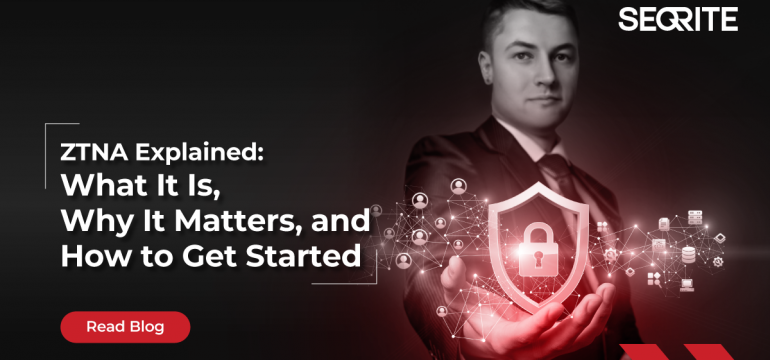In June 2024, a severe data breach shook South Korea’s armed forces. An insider accessed and leaked highly confidential personal information of the country’s undercover agents, jeopardizing their lives.
Incidents like this have become common in today’s rapidly evolving threat environment. Heavy dependence on third-party vendors and remote-first employees, who use VPNs to access sensitive corporate data, has opened many loopholes for threats to infiltrate. Hence, organizations need more secure and adaptable solutions, like Zero Trust Network Access (ZTNA), to protect their networks and resources.
What is ZTNA?
Zero Trust Network Access (ZTNA) is a security approach that ensures strict verification for every user and device before granting access to internal resources. Unlike traditional security models that rely on a perimeter-based approach, ZTNA operates on the principle that threats can originate inside and outside a network. No user or device is trusted by default, whether within the corporate firewall or accessing resources remotely. ZTNA creates isolated, one-to-one connections between users and the specific resources they need. Just as an unlisted number prevents random people from calling you, ZTNA ensures that only authorized users can ‘dial into’ specific applications.
Why ZTNA Matters
The need for ZTNA arises from the significant drawbacks of traditional security measures like VPNs. Once a user connects to a VPN, they can access the entire network, creating a broad attack surface. The risks multiply when the users work from various locations and on different devices, some of which may not be fully secured.
ZTNA, on the other hand, limits access to specific applications or resources rather than the entire network. It also continuously verifies user and device authenticity, reducing the risk of unauthorized access. This approach is especially critical in modern work environments, where Bring Your Own Device (BYOD) policies and cloud-based applications are prevalent. By validating users and devices in real-time, ZTNA ensures that only those meeting the latest security standards are granted access.
How Does ZTNA Work?
ZTNA works by separating application access from network access, ensuring that even if a user is connected to a network, they do not automatically have access to all its resources. Here are some fundamental principles of ZTNA:
- Application vs. Network Access: ZTNA focuses on securing access to specific applications rather than the entire network, minimizing exposure.
- Hidden IP Addresses: Devices connected through ZTNA are only aware of the specific application or service they are authorized to use, keeping the rest of the network invisible.
- Device Security: ZTNA can evaluate devices’ security posture before granting access, ensuring that only secure devices can connect to critical resources.
- Granular Access Control: ZTNA considers multiple factors, such as user identity, location, and the nature of the request, before granting access.
- No MPLS Dependency: Unlike traditional networks that rely on MPLS, ZTNA uses encrypted Internet connections to maintain secure access, providing flexibility and cost savings.
- Integration with IdP: ZTNA solutions often integrate with Identity Providers (IdPs) platforms to streamline user authentication and access management.
ZTNA vs. VPN: Key Differences
While both ZTNA and VPNs provide secure remote access, they differ significantly in their approach:
- Layer of Operation: VPNs often operate at the OSI model’s network layer (Layer 3), while ZTNA typically functions at the application layer (Layer 7) that directly secures access to individual applications without exposing the entire network.
- Software Installation: VPNs generally require endpoint software installation, whereas ZTNA can be deployed with or without endpoint agents.
- Access Scope: VPNs provide broad access to the entire network, whereas ZTNA restricts access to specific applications or resources.
- Hardware Requirements: VPNs may require on-premise servers, while ZTNA is often cloud-based, reducing the need for dedicated hardware.
- Security Posture: ZTNA continuously evaluates the risk associated with each access request, offering a more dynamic and secure approach than the relatively static VPN model.
Getting Started with ZTNA
Implementing ZTNA can seem daunting, but with the right approach, it can be a smooth transition:
- Assess Your Needs: Determine the level of access control required for your organization. Consider factors like the types of devices, applications, and services used, and the locations from which users will connect.
- Choose the Right ZTNA Solution: Depending on your organization’s structure, you may opt for agent-based ZTNA, which requires software installation on devices, or agent-less ZTNA, which operates through the cloud without endpoint agents.
- Integrate with Existing Infrastructure: Ensure that your ZTNA solution integrates seamlessly with your existing identity management systems, such as IdPs and SSO platforms, to maintain a unified security posture.
- Start Small and Scale: Implement ZTNA for a small group of users and applications and gradually expand as your organization adapts to the new security model.
- Monitor and Adjust: Continuously monitor the performance and effectiveness of your ZTNA deployment. Make adjustments as needed to address emerging threats and changing business needs.
Seqrite ZTNA: A Seamless Transition to Zero Trust
Seqrite ZTNA offers a robust solution for organizations adopting the Zero Trust security model. It helps protect enterprise applications and services against unauthorized access by enforcing strict access controls and providing real-time visibility into user activity.
Critical Benefits of Seqrite ZTNA:
- Enhanced Security: Strengthen your organization’s security measures with a Zero Trust approach that verifies every access request.
- Scalability: Easily scale your ZTNA deployment as your organization grows, starting with a few users and applications and expanding over time.
- Seamless Integration: Integrate seamlessly with your existing IT infrastructure, ensuring a smooth transition to ZTNA.
- Improved User Experience: Provide a faster, more reliable remote access experience than traditional VPNs, enhancing productivity across your organization.
As organizations navigate the complexities of remote work and cloud computing, ZTNA offers a modern, flexible, and secure solution that aligns with the demands of today’s digital landscape. By adopting ZTNA, you can protect your network, applications, and data while enabling your workforce to operate securely from anywhere.
For more information about how Seqrite ZTNA can help your organization transition to a Zero Trust security model, visit our ZTNA solution page or contact our team for a consultation.




